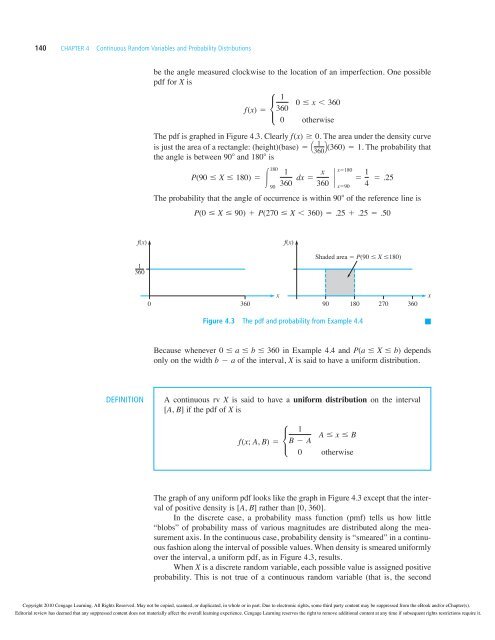Devore Probability Statistics Engineering Sciences 8th txtbk
Devore Probability Statistics Engineering Sciences 8th txtbk
Devore Probability Statistics Engineering Sciences 8th txtbk
- No tags were found...
You also want an ePaper? Increase the reach of your titles
YUMPU automatically turns print PDFs into web optimized ePapers that Google loves.
140 CHAPTER 4 Continuous Random Variables and <strong>Probability</strong> Distributionsbe the angle measured clockwise to the location of an imperfection. One possiblepdf for X isThe pdf is graphed in Figure 4.3. Clearly f(x) $ 0. The area under the density curveis just the area of a rectangle: (height)(base) 5 Q 1 . The probability that360 R(360) 5 1the angle is between 908 and 1808 isP(90 # X # 180) 5 31801f(x) 5 • 360 0 # x , 3600 otherwise901360 dx 5 x x5180360 ` 5 1x590 4 5 .25The probability that the angle of occurrence is within 908 of the reference line isP(0 # X # 90) 1 P(270 # X , 360) 5 .25 1 .25 5 .50f(x)f(x)1360Shaded area P(90 X 180)0 360x90180270360xFigure 4.3 The pdf and probability from Example 4.4■Because whenever 0 # a # b # 360 in Example 4.4 and P(a # X # b) dependsonly on the width b 2 a of the interval, X is said to have a uniform distribution.DEFINITIONA continuous rv X is said to have a uniform distribution on the interval[A, B] if the pdf of X is1f(x; A, B) 5 • B 2 AA # x # B0 otherwiseThe graph of any uniform pdf looks like the graph in Figure 4.3 except that the intervalof positive density is [A, B] rather than [0, 360].In the discrete case, a probability mass function (pmf) tells us how little“blobs” of probability mass of various magnitudes are distributed along the measurementaxis. In the continuous case, probability density is “smeared” in a continuousfashion along the interval of possible values. When density is smeared uniformlyover the interval, a uniform pdf, as in Figure 4.3, results.When X is a discrete random variable, each possible value is assigned positiveprobability. This is not true of a continuous random variable (that is, the secondCopyright 2010 Cengage Learning. All Rights Reserved. May not be copied, scanned, or duplicated, in whole or in part. Due to electronic rights, some third party content may be suppressed from the eBook and/or eChapter(s).Editorial review has deemed that any suppressed content does not materially affect the overall learning experience. Cengage Learning reserves the right to remove additional content at any time if subsequent rights restrictions require it.
















